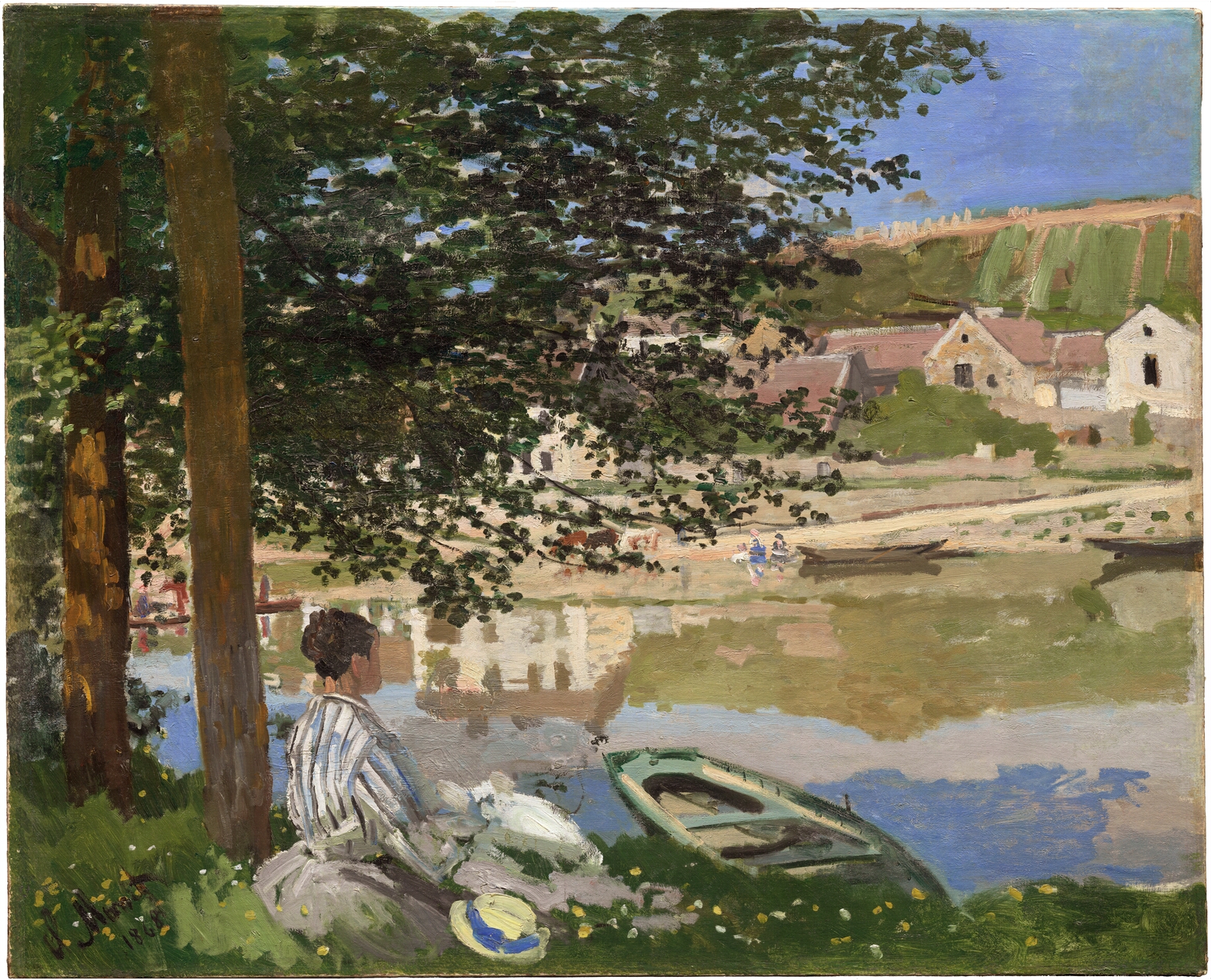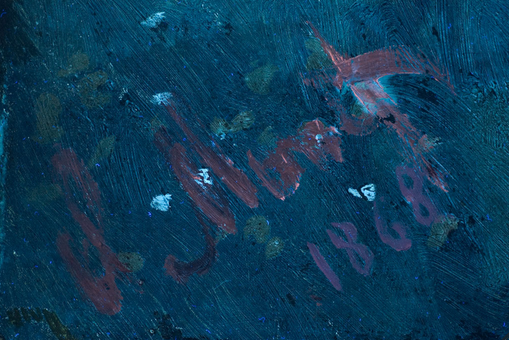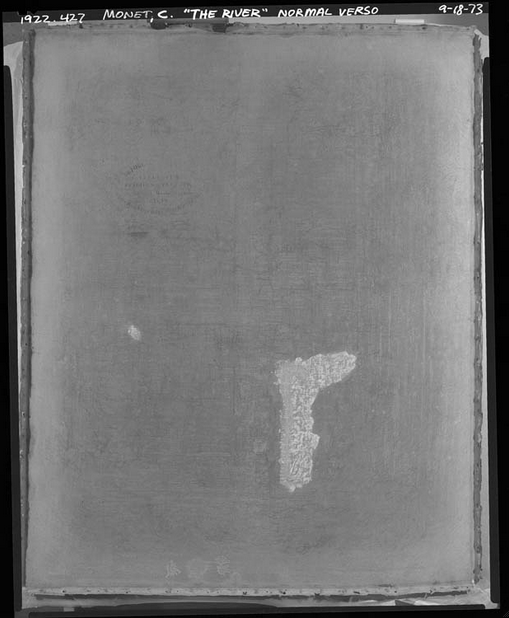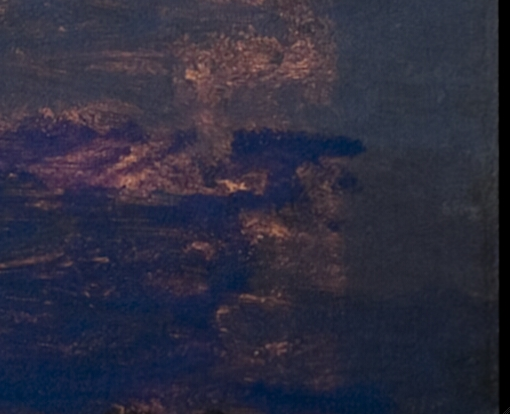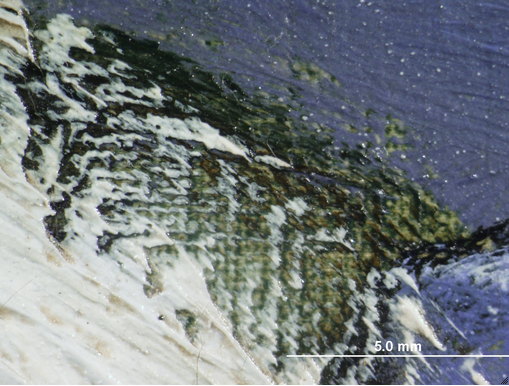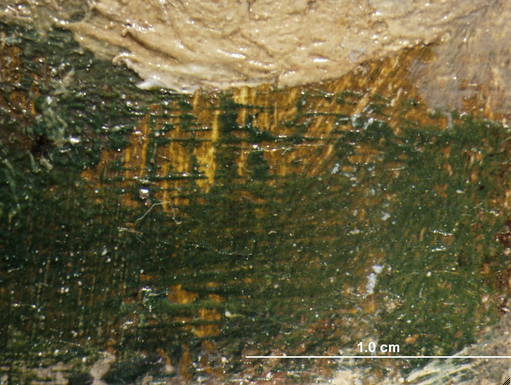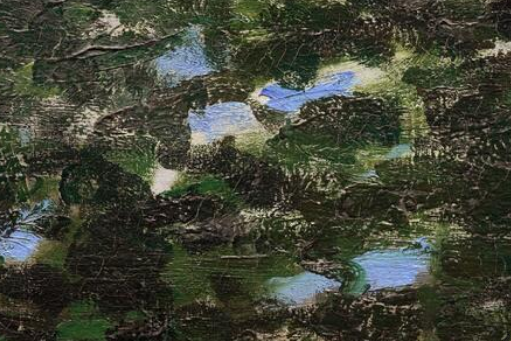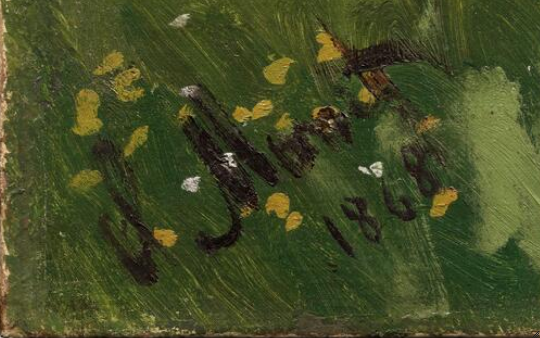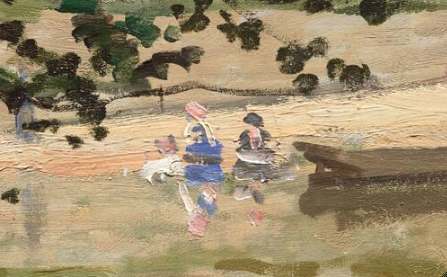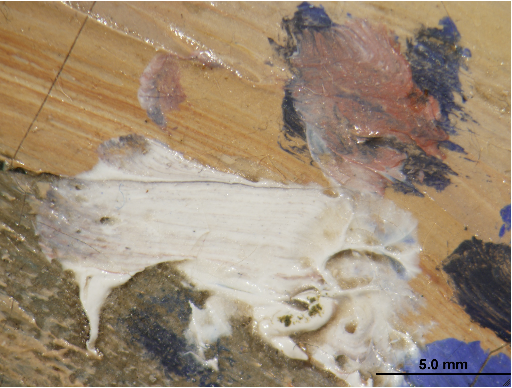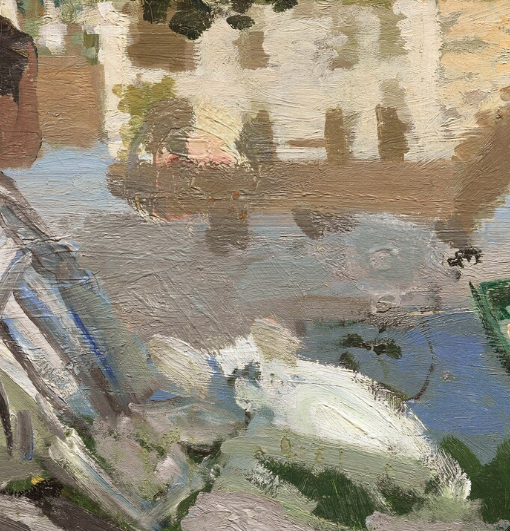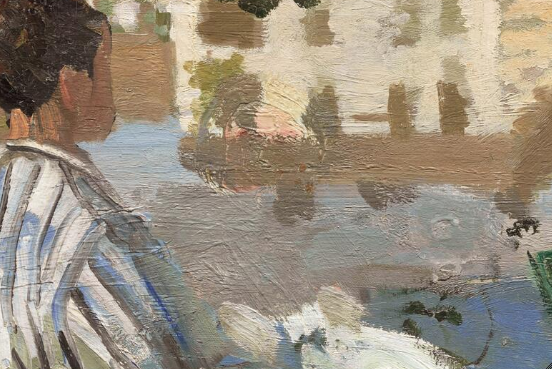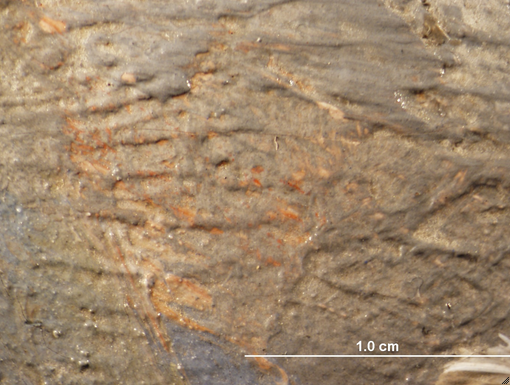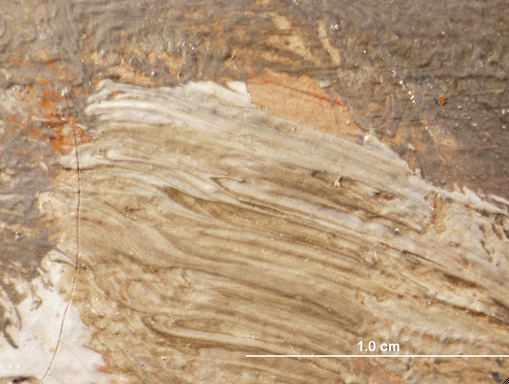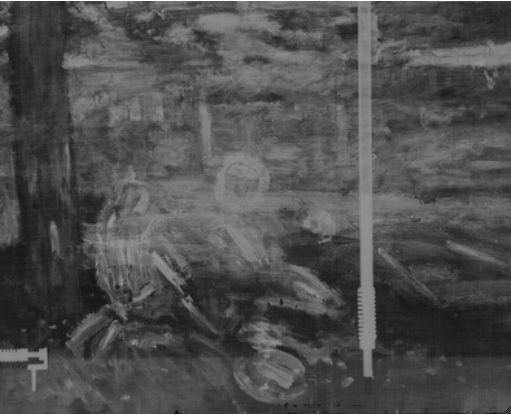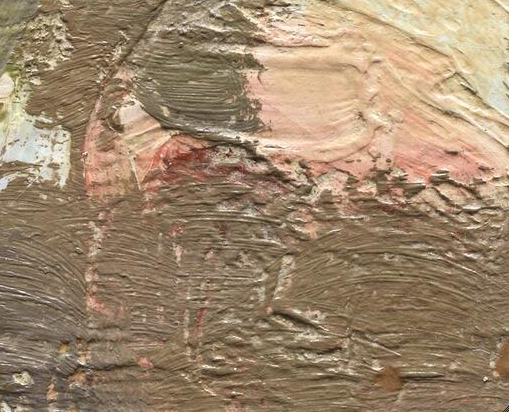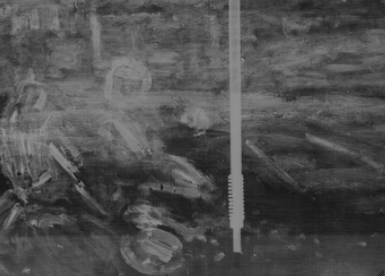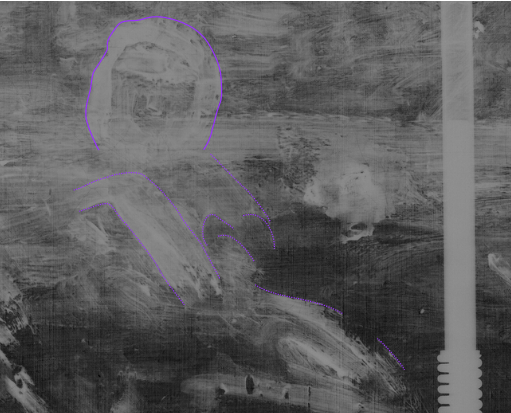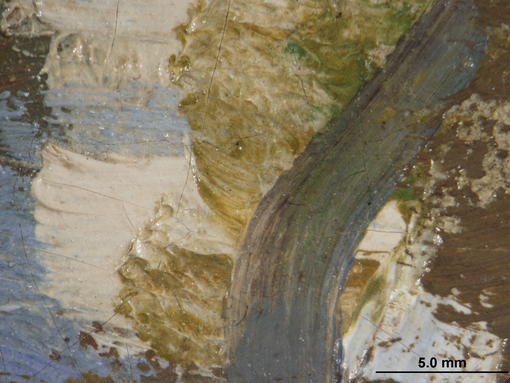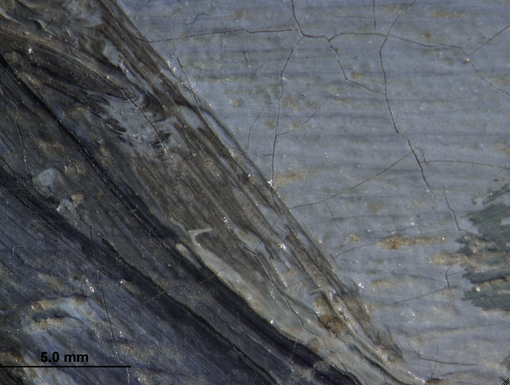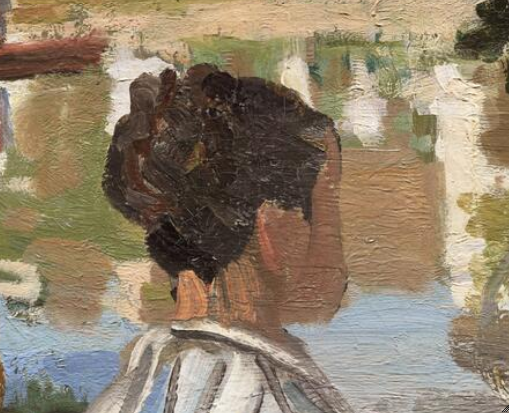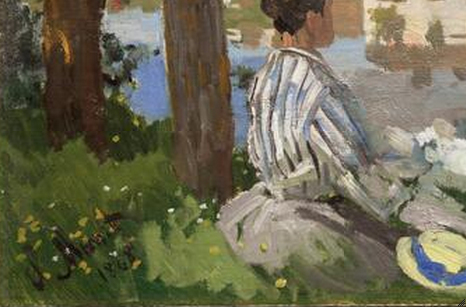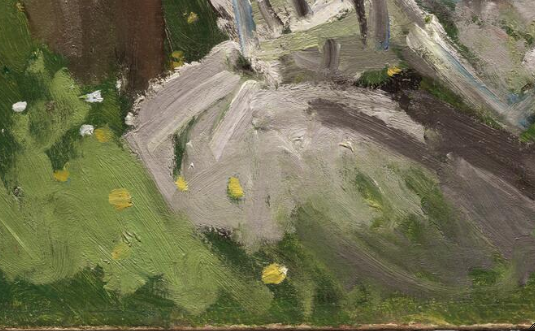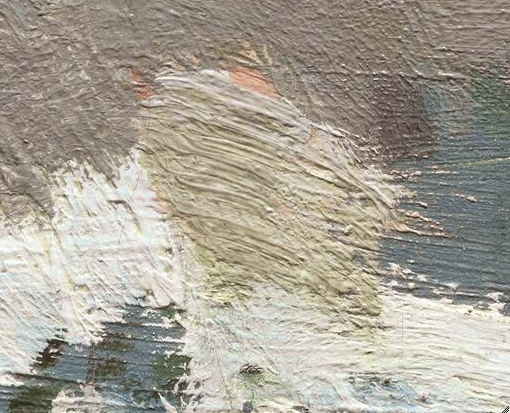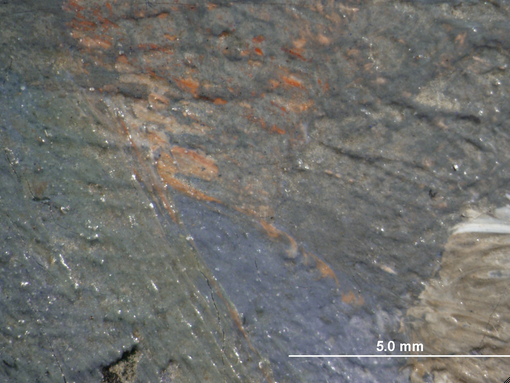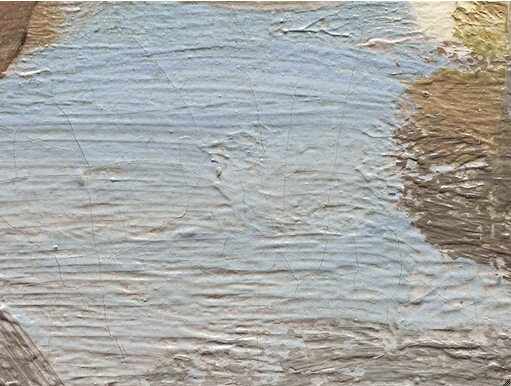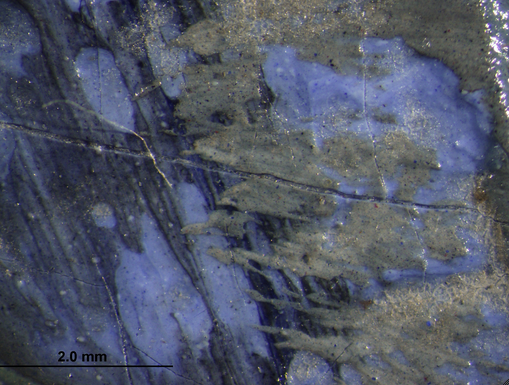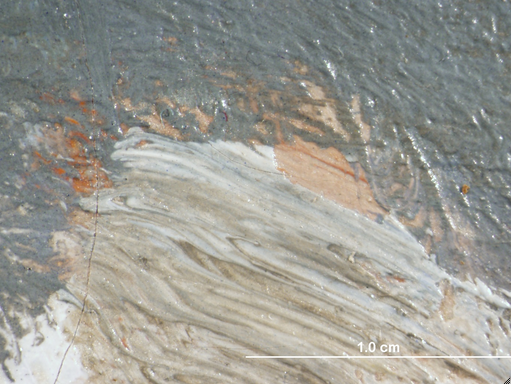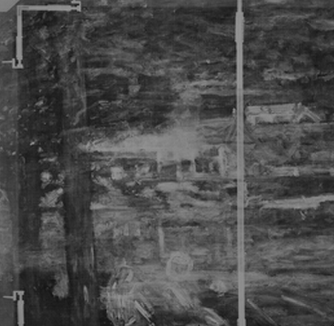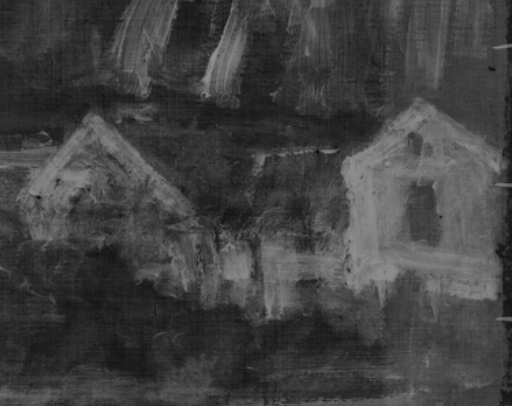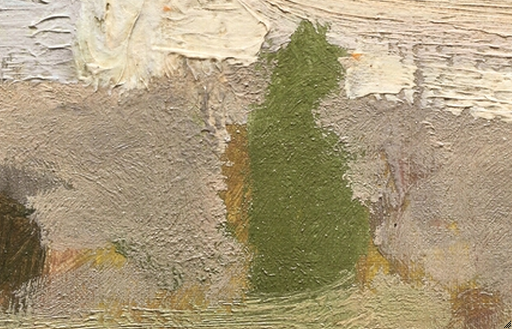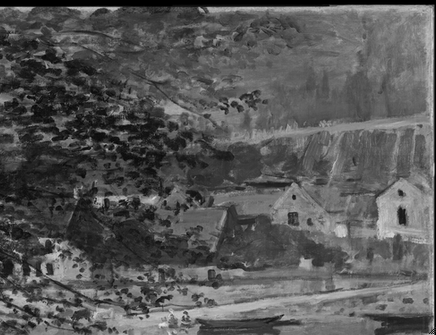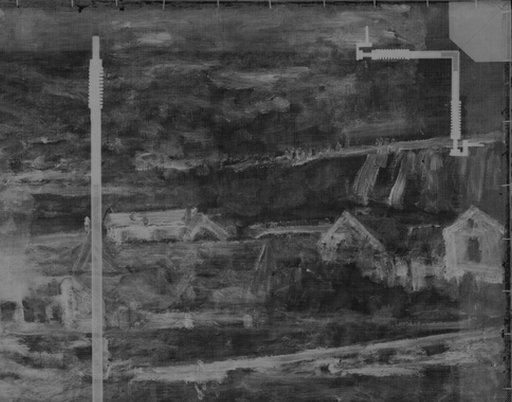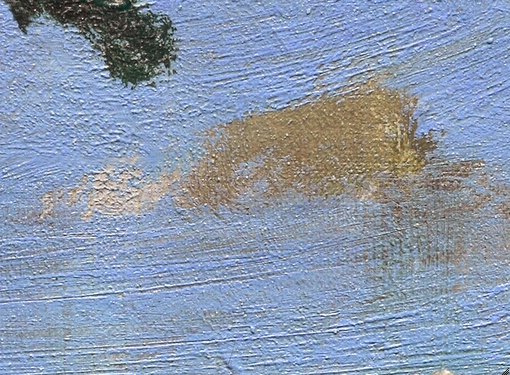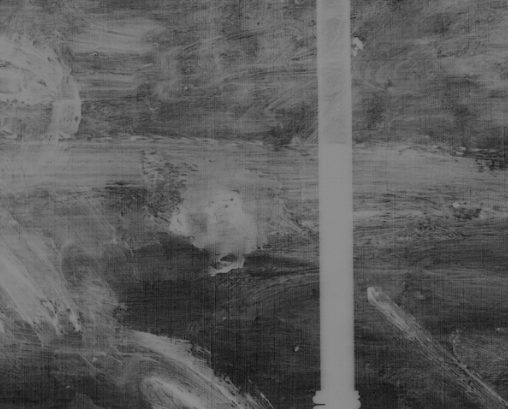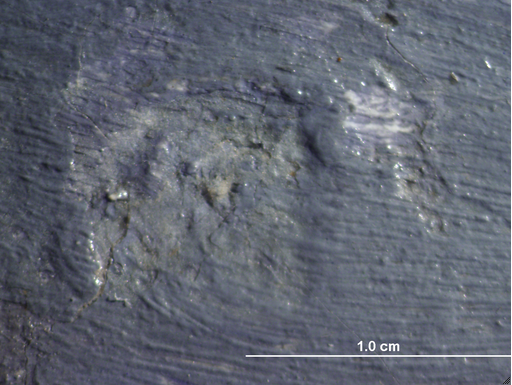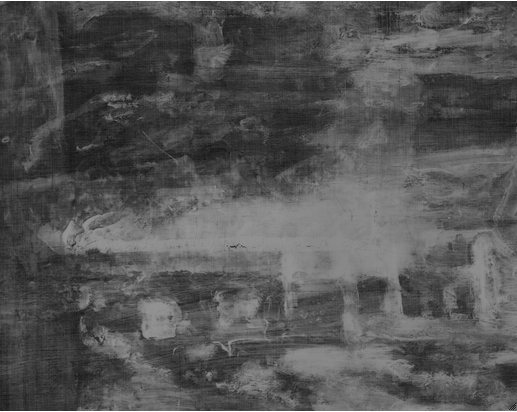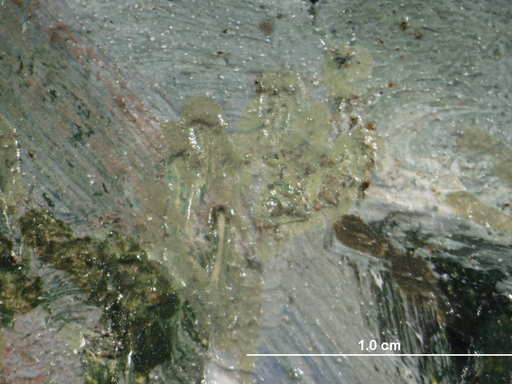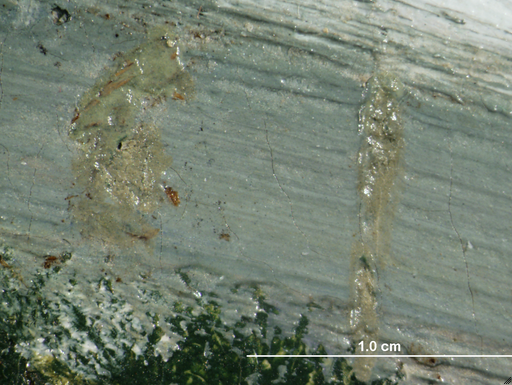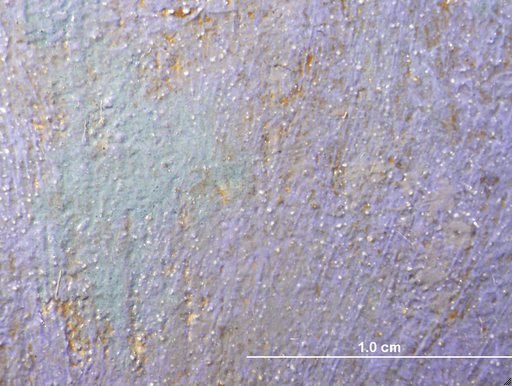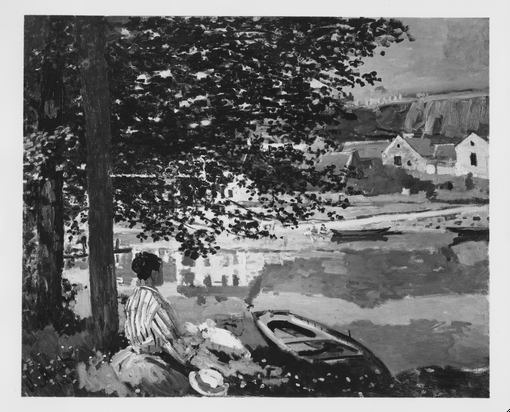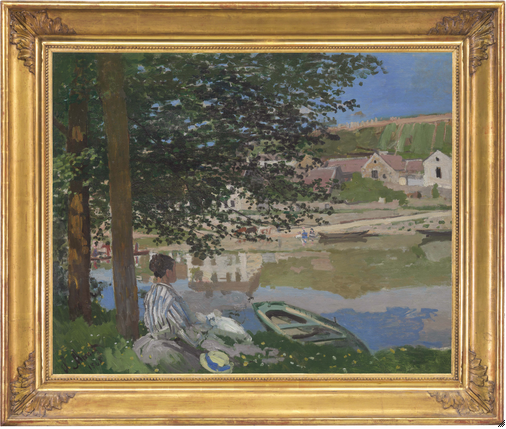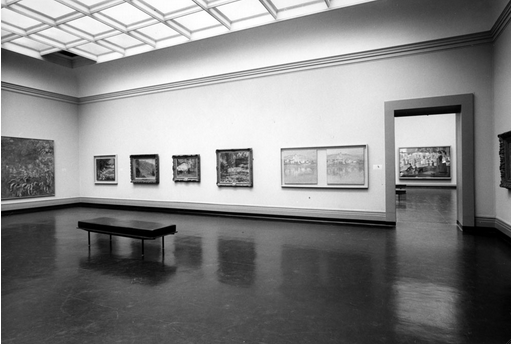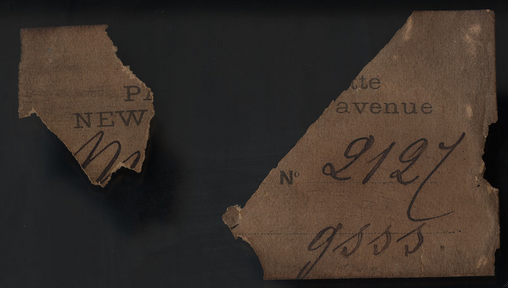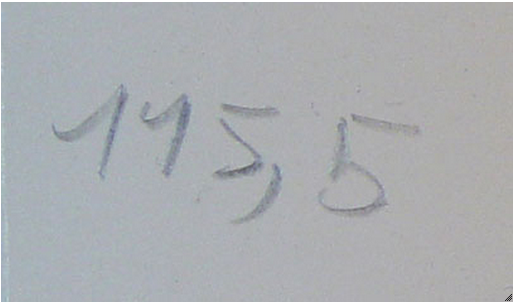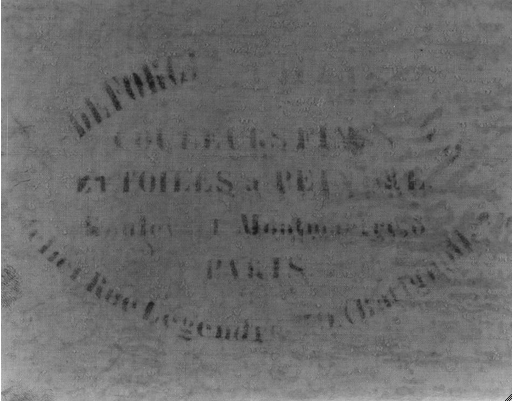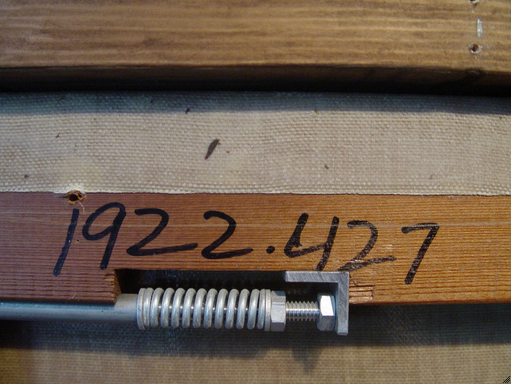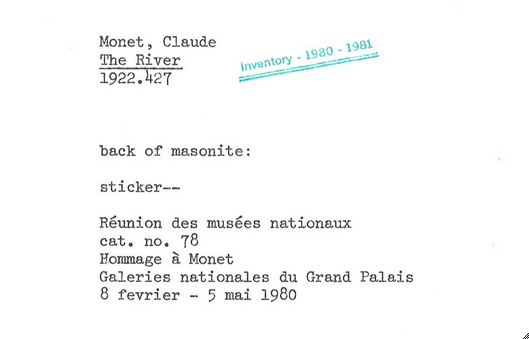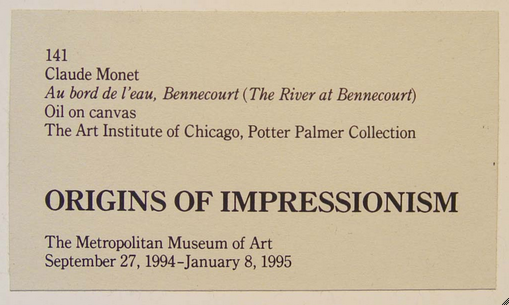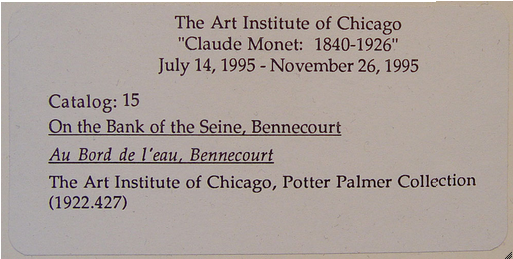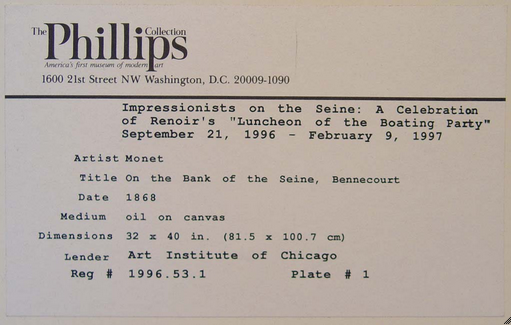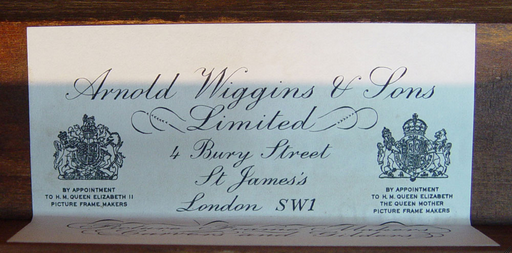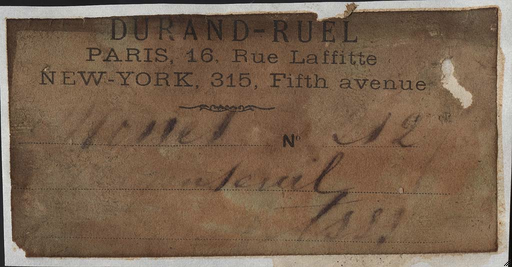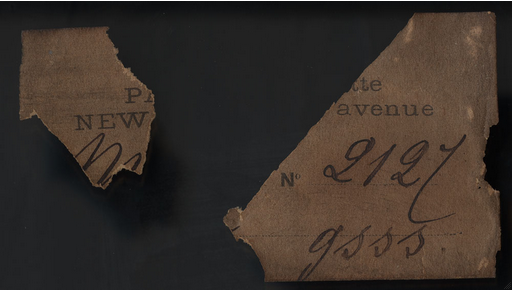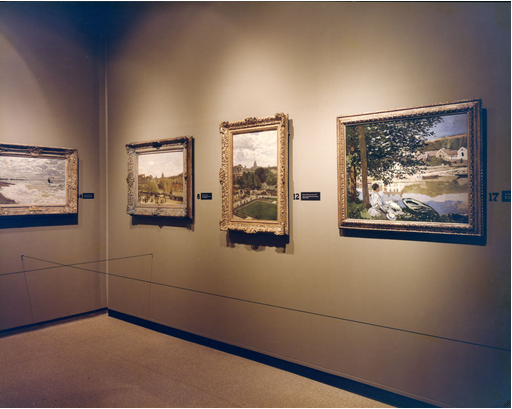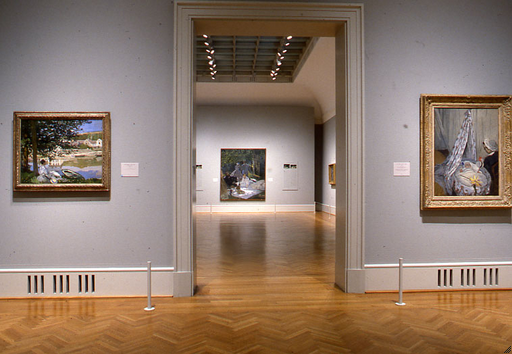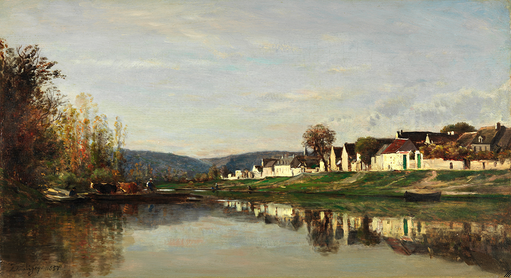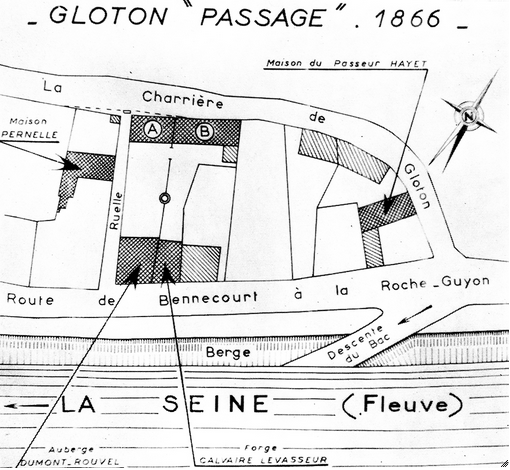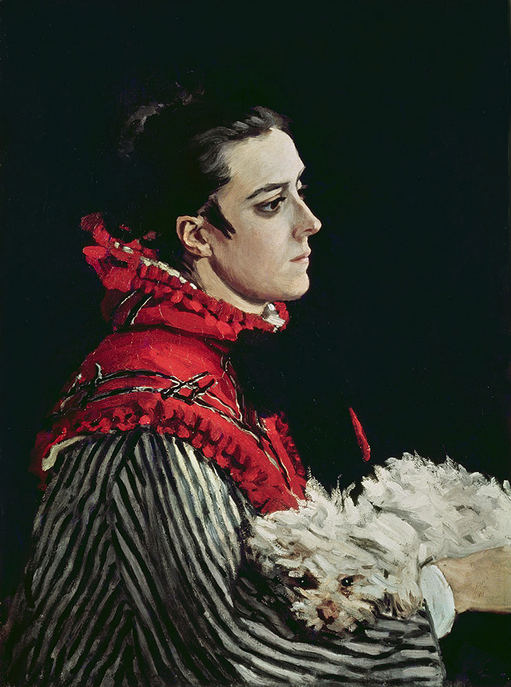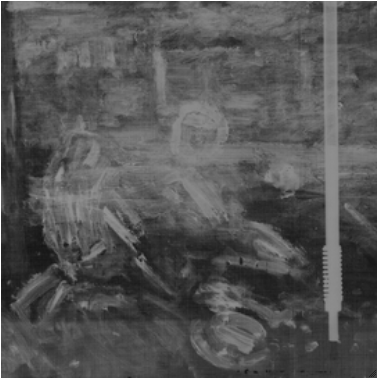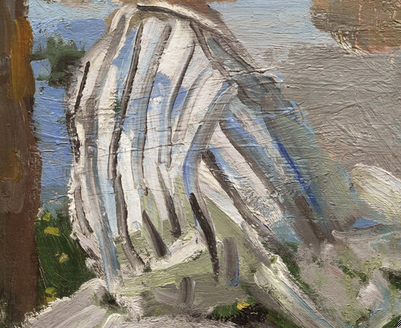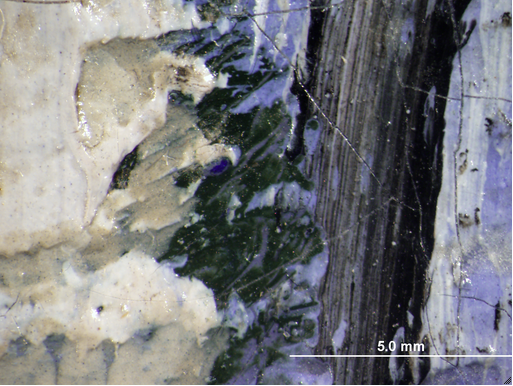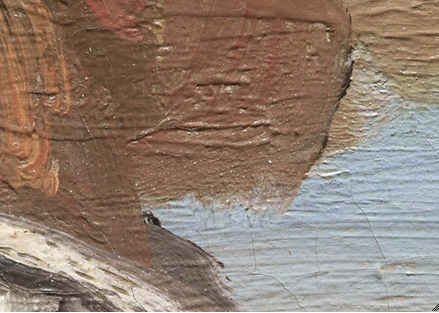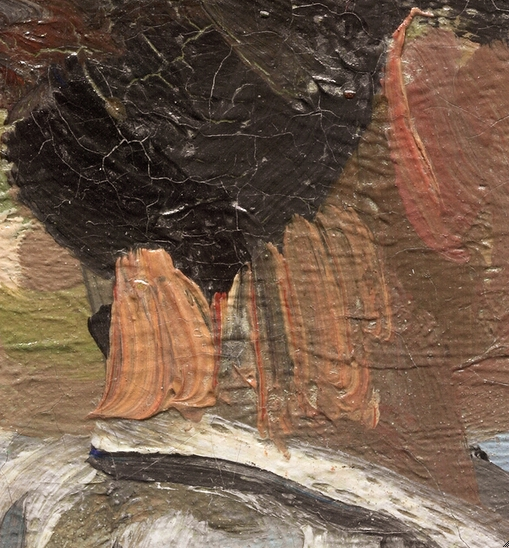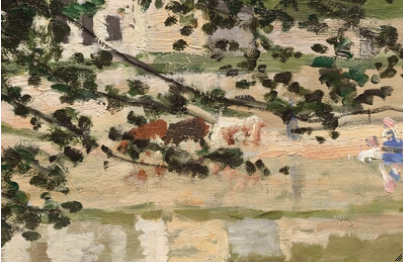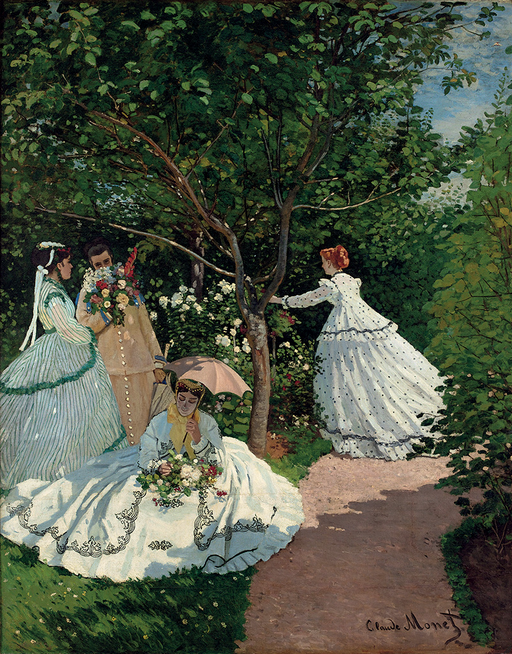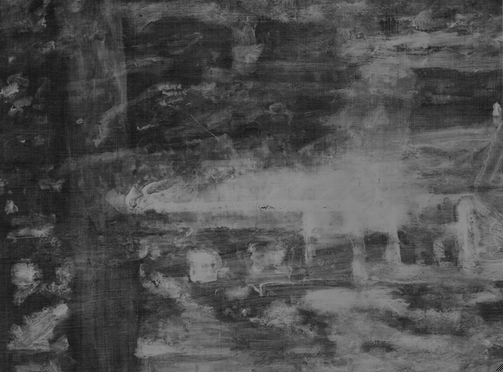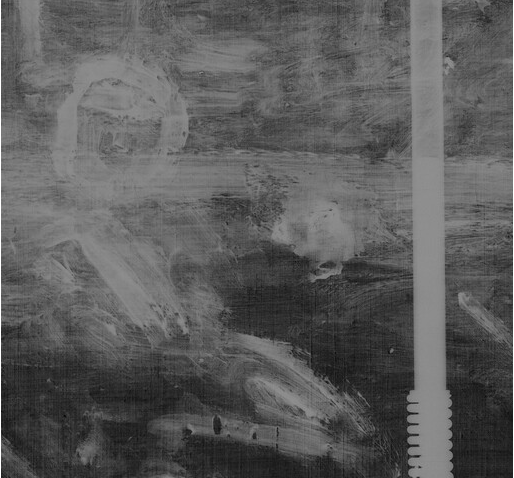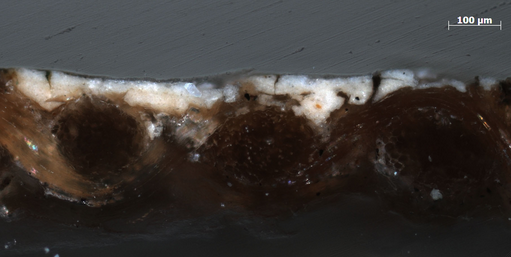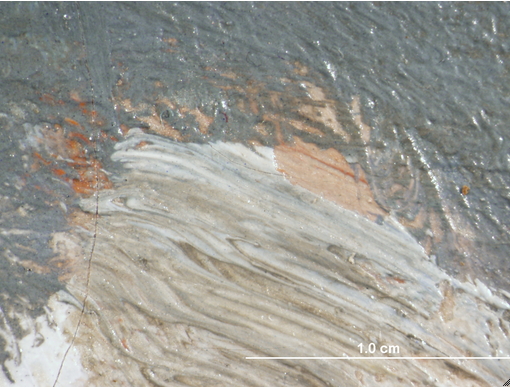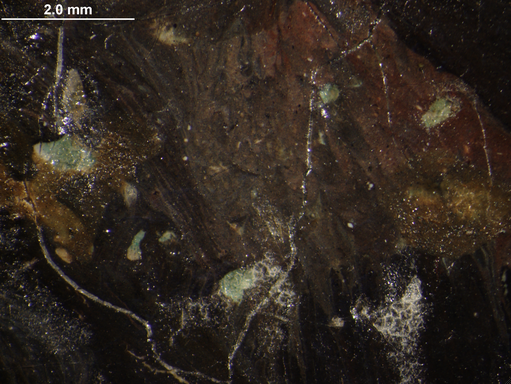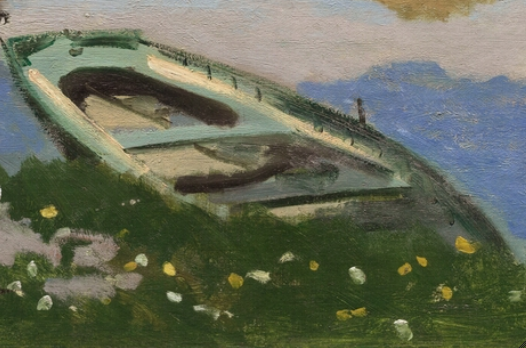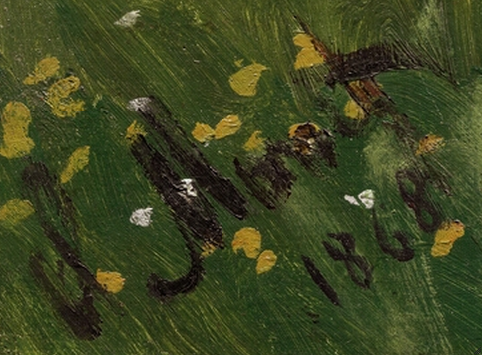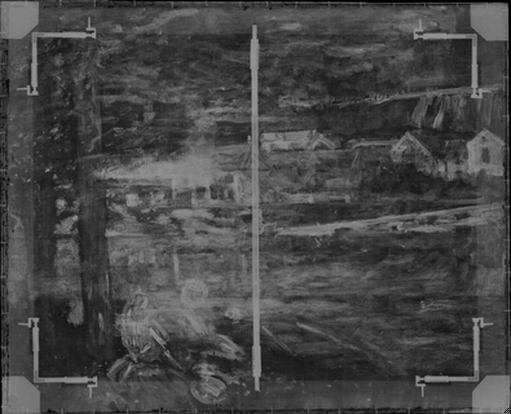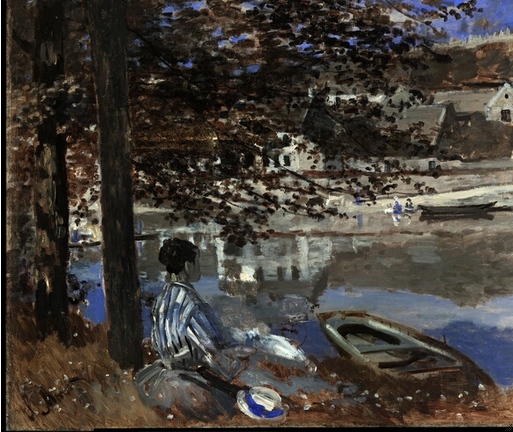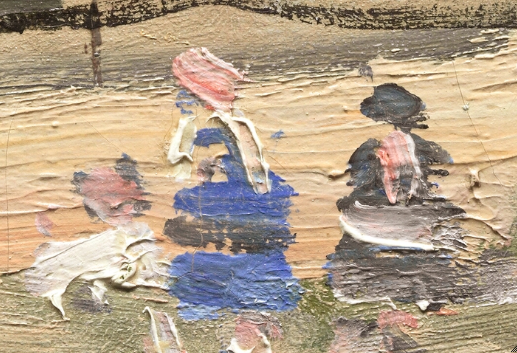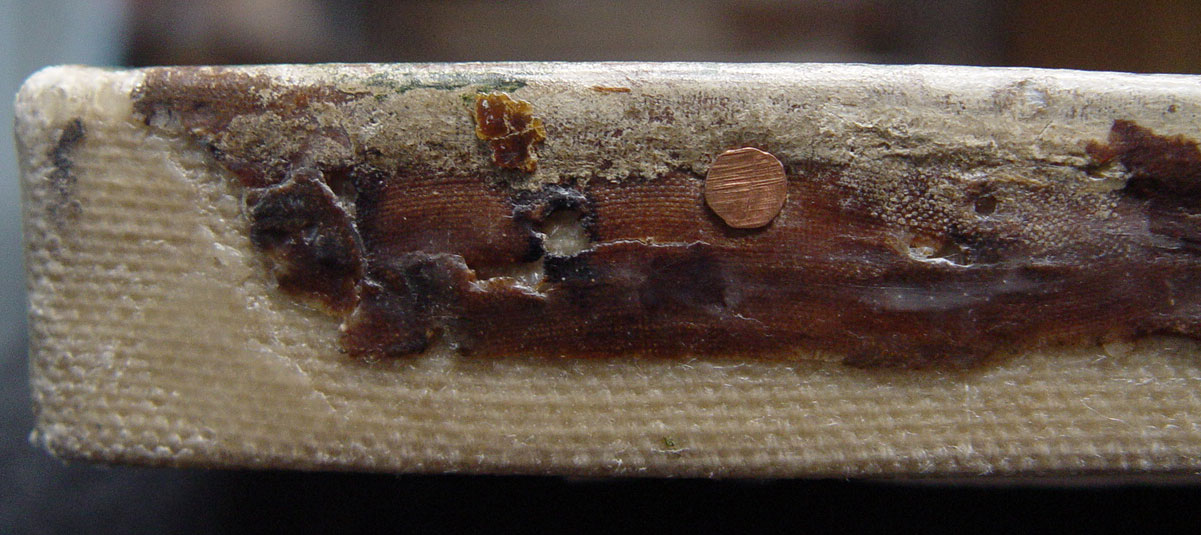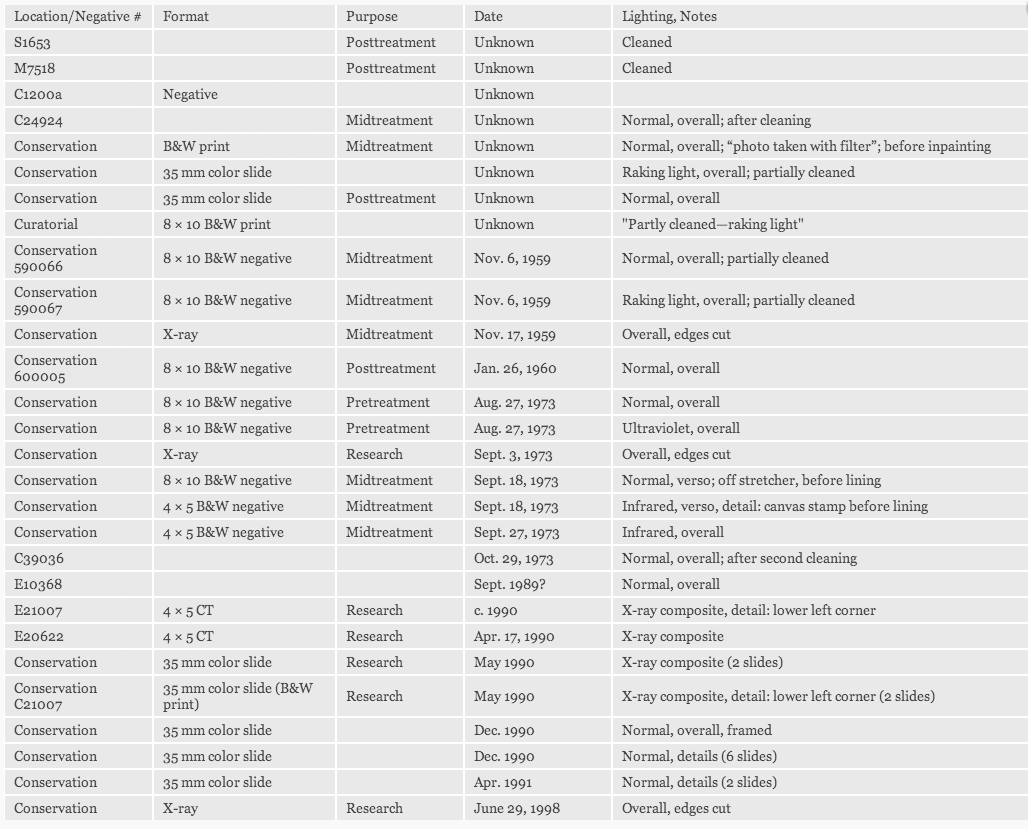Technical Report
Technical Summary
Claude Monet’s On the Bank of the Seine, Bennecourt was painted on a pre-primed, no. 40 portrait (figure), standard-size linen canvas. A stamp from the color merchant Deforge[-Carpentier] was documented on the back of the original canvas before lining. The off-white ground consists of a single layer. A few charcoal particles were observed microscopically in the water on the right side of the painting, which could be related to underdrawing, but insufficient material was observed to draw any conclusions about its nature or extent. The painting was carried out in several sessions and includes some major revisions to the composition, most significantly the painting out of a figure to the immediate right of the female figure. What is perhaps the face of the painted-out figure remains partially visible through the artist’s roughly-applied overpaint. The two figures appear to have been painted within a relatively short time span, and may even have coexisted within the composition at some point. Both figures were added to the work later in the painting process on top of the landscape. The tiny figures and animals on the opposite side of the river were also added later. Other changes made to the landscape include some forms on the hilltop on the right side that were subsequently covered by the sky and alterations to the foreground riverbank in the area of the female figure. It seems that some parts of the reflection in the river capture the landscape and sky at earlier painting stages, resulting in some apparent discrepancies between what is depicted in the actual landscape and what is reflected in the water. There are several old damages to the canvas and paint layers, and repairs and retouching in these areas may date to early in the painting’s history.
Multilayer Interactive Image Viewer
The multilayer interactive image viewer is designed to facilitate the viewer’s exploration and comparison of the technical images (fig. 14.22).
Signature
Signed and dated: Cl Monet 1868 (lower left, dark reddish-brown paint) (fig. 14.23). The signature and date contain similar pigments but are mixed in different proportions, as evidenced by their slightly different hues when viewed under magnification; they also exhibit a slightly different fluorescence from one another under UV, ultraviolet light (fig. 14.24). Both were applied when the underlying paint was dry.
Structure and Technique
Support
Canvas
Flax (commonly known as linen).
Standard Format
The original dimensions were approximately 81 × 100 cm. This corresponds to a no. 40 portrait (figure) standard-size canvas, turned horizontally.
Weave
Plain weave. Average thread count (standard deviation): 28.7V (1.3) × 30.3H (0.8) threads/cm. It was determined that the horizontal threads correspond to the warp and the vertical threads to the weft. No weave matches were found with other Monet paintings analyzed for this project.
Canvas characteristics
There is mild cusping on the left and right sides, with more pronounced cusping along the top and especially along the bottom edge.
Stretching
Current stretching: Dates to 1973 conservation treatment (see Conservation History). Copper tacks spaced approximately 6–7 cm apart. It appears that the canvas was stretched slightly larger than its original dimensions, with approximately 0.5 cm of unpainted tacking margin visible on the left, right, and top edges.
Original stretching: Tack holes spaced approximately 5–7 cm apart.
Stretcher/strainer
Current: Four-membered ICA spring stretcher. Depth: 2.5 cm.
Original: Discarded. An undated pre-1973-treatment report indicates that the previous stretcher consisted of six members, including horizontal and vertical crossbars, with mortise and tenon joints and keys. The report gives the following dimensions: overall, 82 × 100 cm; outside depth, 2 cm; inside depth, 2 cm; width, 6.5 cm.
Manufacturer’s/supplier’s marks
There is a supplier’s stamp on the back of the original canvas, which was photographed before the painting was lined in 1973 (see Conservation History): “DEFORGE . . . / COULEURS FINES / ET TOILES à PEINDRE / [Boulevard] Montmartre, 8 / PARIS / Atelier Rue Legendre . . . Batignolles”(fig. 14.25, fig. 14.26).
Preparatory Layers
Sizing
Not determined (probably glue).
Ground application/texture
The ground extends to the edges of the top, left, and right tacking margins but appears to stop short of the bottom edge (fig. 14.27). This indicates that the canvas was cut from a larger piece of primed fabric on the top, left, and right sides; the bottom edge probably corresponds to the edge of the larger roll of canvas that was attached to the frame during priming. The canvas was probably commercially prepared. The ground consists of a single layer that ranges from approximately 15 to 80 µm in thickness (fig. 14.28).
Color
The ground layer is off-white.
Materials/composition
Analysis indicates that the ground contains lead white with minor amounts of iron oxide red and yellow, and traces of bone black, alumina, calcium-based white, barium sulfate, and silicates.
Compositional Planning/Underdrawing/Painted Sketch
Extent/character
No evidence of underdrawing was detected with infrared reflectography; however, a few localized areas of black particulate matter were observed microscopically in the water, on the right side of the painting (fig. 14.29). It is uncertain whether this material is related to preparatory drawing. In some areas, the black particles seem to lie on top of the paint layer and may have been picked up by the brush in the process of painting (fig. 14.30).
Medium/technique
Charcoal.
Revisions
If the material is related to preparatory drawing, the amount observed on the surface of the painting is insufficient to draw any conclusions about the extent of the underdrawing or any revisions to the original compositional plan.
Paint Layer
Application/technique and artist’s revisions
Most of the landscape was built up in broad, relatively flat planes of color. In some areas, the paint was quite thinly applied, especially at the junctures of forms, where the ground layer remains partially exposed (fig. 14.31). It appears that the composition was laid in with thin layers of more subdued tones than those used in the final painting; for example, dull greens and earth tones are observed throughout the landscape (fig. 14.32, fig. 14.33). The underpainting of the sky varies from warm cream to pinkish-gray and continues underneath the foliage to the left edge of the painting. The brush-marked texture of this underlayer remains visible at breaks in the brushwork and through some of the thin layers of paint applied on top (fig. 14.34). The streaky, more radio-opaque forms visible in the upper-left corner seem to correspond to this underlayer (fig. 14.35). Most of the foreground bank was quickly brushed in using dilute green paint; further buildup in this area was mostly limited to the touches of white and yellow flowers (fig. 14.36). The painting was carried out in several sessions and includes both wet-over-dry and wet-in-wet paint application at various stages. The landscape was well established before any of the figures or animals were added. The female figure in the foreground, as well as the figures and animals on the other side of the river, were painted on top of the landscape, in some cases, when the brushstrokes from the landscape were already surface dry (fig. 14.37, fig. 14.38).
Several compositional changes have been made to the painting, and some areas were never fully resolved by the artist. This makes it somewhat challenging to reconstruct the evolution of the work. It is clear, even to the unaided eye, however, that another figure was originally included in the composition immediately to the right of the female figure. This figure was subsequently painted out, but elements of what may be the head and face remain partially visible on the surface (fig. 14.39). The brushwork outlining the head, which is rather thick and suggestive of a hat or a bonnet, and the flesh-toned paint of the face can be seen through the thin layers of artist’s overpaint applied on top (fig. 14.40). One interpretation of this pentimento is that the figure is a child who stands on the female figure’s lap, facing out toward the viewer. There are two other localized areas of flesh-colored paint, partially visible underneath the gray, artist’s overpaint further down in the composition (fig. 14.41, fig. 14.42, fig. 14.43). These areas have been interpreted as the right hand of the woman grasping the right hand of the child (on the left side) and the outstretched left hand of the child (on the right side). The recent technical examination offers an alternative interpretation for consideration, namely, that the painted-out figure is an adult female, who sits facing the viewer (fig. 14.44). The scale of the head and the facial features (which seem to be indicated by localized areas of deep-red paint partially visible on the surface) (fig. 14.45) may be more in keeping with an adult figure than a child. The radio-opaque, lead white–rich strokes, which are visible in the X-ray below the head and continue down to the edge of the grassy bank, seem to be related to the body of the painted-out figure (fig. 14.46). The upper part of this white brushwork was roughly covered by the artist while the lower area was incorporated into the final painting and has sometimes been interpreted as a dog perched on the female figure’s lap. Further examination of the X-ray reveals another form just below the painted-out head. It is tempting to read this as the head of an infant child or a doll wearing a bonnet (possibly cradled in the lap of the painted-out figure)—and, in fact, one of the small areas of flesh-toned paint corresponds to where the face of this child or doll would be located (fig. 14.47)—but this is more speculative (fig. 14.48).
Both the painted-out figure and the final female figure were painted on top of the landscape, the water, and the reflections of the buildings. In some places, the paint from the landscape was still wet. For example, the gray stroke on the left edge of the painted-out head was dragged through the still-soft paint of the corner of the reflected building and the foliage from the layers underneath (fig. 14.49). Similarly, the edge of the final female figure’s right shoulder appears to be wet-in-wet with the pale-blue-gray paint layer of the water (fig. 14.50). The buildings and foliage reflected in the water continue underneath the edge of this figure’s head (fig. 14.51) and are visible microscopically through drying cracks and tiny gaps in her hair (fig. 14.11); the hair appears to have been painted wet-on-wet with the thick white strokes of the building’s reflection at the upper front and back of the head (fig. 14.52). It is evident, through the open brushwork of the blue-striped dress, which becomes increasingly sketchy below the figure’s waist, that her body was also painted over the water, grass, and foliage (fig. 14.53). In the area of the water to the left of the figure’s back, dark-green paint is sandwiched between layers of blue from the water. This seems to indicate that at one point the grassy bank was extended further out over the water on the left side of the painting (fig. 14.54, fig. 14.55). In the area between the two tree trunks, the grass itself, including one of the yellow flowers continues underneath the upper blue layer where the water was extended over the grass. Some of the dark-green paint from the earlier shoreline can still be seen through the open brushwork of the woman’s dress (fig. 14.55). In this area, the green paint appears to have been applied wet-in-wet over a pale-blue layer, presumably the first painting of the river. The brighter-blue layer applied on top was added when the underlying greenery was dry. This bright-blue paint from the water continues under the figure’s back, where it stands in for the blue stripes of the dress in places (fig. 14.56). The blue paint looks like it was still slightly wet in places when the dress was painted. The skirt was painted on top of the grass and some of the yellow flowers (the two at waist level), while the two lower flowers were added on top of the skirt (fig. 14.57). The pale-green patch of grass and yellow flowers left of the figure were also added later; there is some wet-in-wet mixing with the pale gray of the edge of the skirt. The bright white strokes to the right of the woman (sometimes interpreted as a dog), appear to have originally been part of the painted-out figure. The white brushwork was also applied over the brighter blue of the water and some of the dark-green and brown paint (applied wet-in-wet on top of the water) that appears to be related to a branch or vine (or reflection of such) that continues on either side of the white form (fig. 14.58). The small flesh-tone area just above the white strokes appears to lie on top of the white paint (fig. 14.59). The other flesh-colored paint stroke, further to the left, seems to have been picked up by the edge of the striped dress, suggesting that it was still wet when the dress was painted (fig. 14.60). All of these observations seem to indicate that both the final female figure and the painted-out figure were painted on top of the landscape after some changes to the shoreline had been made. Furthermore, since both figures show evidence of some wet-in-wet mixing with the landscape, they were probably painted within a short time span of one another, if not contemporaneously, suggesting that they may have coexisted in the composition at some point. It seems that the rowboat in the foreground also may not have been included in the composition from the beginning. The back part of the boat was painted on top of the first layers of the water, and the front half was added over a thin green wash that may correspond to the original lay-in of the riverbank (fig. 14.61). The grass where it overlaps the boat and the bright-blue patch of water to the right of the boat were added last in this area.
The fact that the paint used to cover the figure does not disturb the ridges of the underlying brushmarks, as well as the presence of several small areas of interlayer cleavage between the two painting campaigns (fig. 14.62), suggests that the figure was at least surface dry when the artist painted it out. The gray paint that covers the torso only overlaps the final female figure along the edge of her right arm but it seems that the paint from her dress was also dry at this point (fig. 14.63). The gray overpaint appears to have been painted up to the lower right flesh-toned area; the “flesh” area was then obscured by the thick, grayish-white stroke (fig. 14.64). Although it cannot be ruled out that the artist’s overpaint has been thinned or compromised in past cleanings, it does seem that Monet was not overly concerned with completely concealing all traces of the earlier figure and that its presence was always visible to some extent.
A few other more minor changes to the composition were observed. It appears that early in the painting, forms related to the sky, the tree foliage, and the river were laid in underneath the two tree trunks, suggesting that these compositional elements were blocked in on the left side before the tree trunks were added. However, the painting could not have been very far developed when the trunks were incorporated, as they remain relatively radio-transparent and the river and village were largely built up around them (fig. 14.65). In front of the houses near the right edge, a few other painted-out forms are visible in the transmitted IR and X-ray images. These may be related to additional windows and greenery that were later painted out (fig. 14.66); for example, a painted-out area of green can be seen, microscopically, to the left of the shrub that is in front of the white house at the far right, perhaps suggesting that more shrubbery was planned there (fig. 14.67). Further revisions appear to have been made to the sky in the upper right corner of the painting. Brushwork unrelated to the final composition is revealed with the aid of infrared and [glossary:transmitted infrared imaging] (fig. 14.68). It is unclear what this earlier brushwork depicted but it seems like the warm, terracotta color of the underlayer of the hill continues underneath the sky. In the upper right corner, this warm-toned layer continues in a broad band all the way to the top of the canvas (fig. 14.69), and interestingly, in the final painting, the reflection of the sky in the river seems disrupted in this area, as though a form was being reflected there. The pale, brush-marked underpainting that initially covered most of the sky also seems to stop when it reaches this area in the upper right corner, suggesting that some form was blocked into the corner early on (fig. 14.70). The warm-toned paint of the pentimento is also visible in a small area further to the left, where there is a gap in the blue paint of the sky (fig. 14.71). This small peak also seems to have been incorporated into the reflection, suggesting that the sky was reworked after the reflection was painted. In fact, there seem to be several discrepancies between the village and its reflection; for example, more of the green hillside but not all of the buildings are included in the reflection. Furthermore, the hillside seems out of scale with the reflection of the large white building to the left. This could suggest that the reflection represents an earlier stage of the composition.
Several damages appear to have occurred early in the painting’s history. There is a large, L-shaped tear, which was repaired and filled early on using a lead white–rich paint or adhesive. This shows up as a radio-opaque area in the X-ray (fig. 14.72). Another damage, possibly a small puncture in the canvas, just to the right of the painted-out figure, was treated in a similar way. The repair creates a roughly circular form on the surface of the painting (fig. 14.73, fig. 14.74). It is unclear when or by whom the repairs were carried out, however, it cannot be ruled out, that Monet himself may have had a hand in them. In any case, the nature of the retouching in the larger tear area, which is more dense and solid than the rest of the foliage, raises the question of whether the foliage was originally painted this densely. The X-ray indicates that the buildings on the far shore were painted in some detail right up to the tree trunk (fig. 14.75). It seems questionable that Monet would have developed the buildings to this degree, only to obscure them with the dense foliage. In fact, this runs counter to the technique he used to depict glimpses of sky peeking through the foliage: rather than painting broad strokes of blue sky, then adding the foliage on top, localized touches of blue were applied over the initial lay-in of the foliage, with additional leaves built up over that (fig. 14.76). Other signs of damage include gouges in the soft paint, particularly in the lower center area (fig. 14.77, fig. 14.78).
Painting tools
Brushes, including 1–2 cm width, flat ferrule (based on width and shape of brushstrokes).
Palette
Analysis indicates the presence of the following pigments: lead white, bone black, chrome yellow, yellow, red, and brown iron oxides including burnt sienna, vermilion, red lake, emerald green, viridian, cobalt blue, and ultramarine blue. Relatively large white clumps are visible microscopically throughout the paint surface, imparting a distinct bumpy surface (fig. 14.79). This may be associated with the lead white paint used by the artist. UV fluorescence suggests the use of red lake in the signature and date.
Binding media
Oil (estimated).
Surface Finish
Varnish layer/media
The painting has a relatively matte, synthetic varnish, which was applied in 1973. In the 1973 treatment, a yellowed, natural-resin varnish was removed. The application of the natural-resin varnish is not documented but must postdate the 1959 varnish removal (see Conservation History).
Conservation History
Undocumented restorations associated with damages in the canvas (an L-shaped tear in the upper left quadrant and a possible puncture at lower center (see Condition Summary) appear to be quite old. These areas were repaired using a lead white–containing material, probably applied from the front and the back of the canvas, to act as a consolidant for the tear and serve as a fill material for the retouching. The repairs were carried out before the aqueous lining that is documented as early as 1957 and was removed in the 1973 treatment (see below).
In 1959, discolored (extremely yellowish-gray) varnish was removed.
In 1973, discolored surface films and overpaint were removed (fig. 14.80). The aqueous lining was removed, along with excess lead white paint on both sides of the tear. The painting was wax-resin lined and stretched on to a new ICA spring stretcher. A coating of polyvinyl acetate (PVA) AYAA was applied and inpainting was carried out. A coating of methacrylate resin L46 was applied, followed by a final coating of PVA AYAA.
Condition Summary
The painting is in good condition overall but suffers from old damages and restorations. The canvas is wax-resin lined and stretched on an ICA spring stretcher. The spring stretcher is slightly larger than the original stretcher, resulting in a border of unpainted ground from the tacking margins around the edges. There is an L-shaped tear in the canvas, in the upper-left quadrant, in the area of dense foliage above the figure’s head. It measures approximately 19 cm in the horizontal direction and 4 cm in the vertical direction. There is another damage in the foreground, just to the left of the back end of the rowboat, which appears to be a puncture in the canvas. Both areas of damage were somewhat crudely repaired with a lead white–containing material. The repairs appear to be quite old and were carried out at least before the aqueous lining, which was first documented in 1957. Other small damages in the paint were observed in the area of the painted-out figure and appear to have occurred when the artist’s “overpaint” was still soft. Retouching associated with these damages is slightly mismatched. There is extensive retouching around all of the edges associated with the border of exposed ground mentioned above. Other localized areas of retouching are scattered throughout the painting. There is a concentrated area of retouching in the upper right corner; its purpose may have been to conceal the warm-brown underlayer in that area, which may have become more noticeable over time. There are a few tiny, localized areas of interlayer cleavage between the artist’s “overpaint” and the painted-out figure. These areas are secure. There are some areas of crushed impasto, likely the result of pressure from the lining treatments. There are some fine age cracks visible throughout the painting and a fairly extensive network of fine drying cracks in the dark green and brown paint of the trees and the sitter’s head. The surface is coated with a synthetic varnish, which has a relatively matte finish.
Kimberley Muir
Frame
Current frame (2008): The frame is not original to the painting. It is a French, mid-nineteenth-century, reverse-ogee frame with composition acanthus-leaf miters, a hollowed frieze, and a composition beaded sight molding. The frame is water gilded over red bole on gesso and composition ornament. The torus and hollow are burnished; the rest of the gilding was left matte and retains its original glue size. There is casein overpaint on the sides of the frame. The fruitwood molding is mitered with angled dovetailed splines. The molding, from perimeter to interior, is fillet; torus (three-quarter round) with a step; reverse ogee with composition acanthus-leaf ornament at the miter; fillet; hollow; fillet; frieze with beaded composition ornament; and cove sight (fig. 14.81).
Previous frame (removed 2008): The work was previously housed in an American (New York), mid-twentieth-century reproduction of an Italian Baroque frame with a bolection profile with spiral-leaf outer molding and a centered laurel-leaf sight molding. The frame has a white-gold distressed finish and an independent liner with a beveled sight (fig. 14.82).
Previous frame: Sometime between 1956 and 1962, the work was housed in a painted shadow box. The painting’s stretcher was mounted to the back panel of the frame with the edges of the canvas exposed. The frame was probably only utilized during this installation (fig. 14.83).
Kirk Vuillemot
Selected References
Galerie Georges Petit, Claude Monet—A. Rodin, exh. cat. (Imp. de l’Art, 1889), p. 28, cat. 7.
Copley Society, Boston, Loan Collection of Paintings by Claude Monet and Eleven Sculptures by August Rodin, exh. cat. (Copley Society, 1905), p. 25, cat. 78.
Art Institute of Chicago, Paintings from the Collection of Mrs. Potter Palmer, exh. cat. (Art Institute of Chicago, 1910), cat. 40 or cat. 41.
Art Institute of Chicago, Annual Report (Art Institute of Chicago, 1921), (ill.).
Art Institute of Chicago, “Library Notes,” Bulletin of the Art Institute of Chicago 15, 5 (Sept.–Oct. 1921), p. 160 (ill.).
Art Institute of Chicago, “Accessions and Loans,” Bulletin of the Art Institute of Chicago 16, 3 (May 1922), p. 47.
Art Institute of Chicago, Handbook of Sculpture, Architecture, and Paintings, pt. 2, Paintings (Art Institute of Chicago, 1922), p. 68, cat. 831.
Art Institute of Chicago, “The Potter Palmer Collection of Paintings,” Bulletin of the Art Institute of Chicago 16, 3 (May 1922), p. 38.
Art Institute of Chicago, A Guide to the Paintings in the Permanent Collection (Art Institute of Chicago, 1925), pp. 62 (ill.); 146, cat. 831.
M. C., “Monets in the Art Institute,” Bulletin of the Art Institute of Chicago 19, 2 (Feb. 1925), pp. 18 (ill.), 19.
Art Institute of Chicago, Catalogue of “A Century of Progress”: Exhibition of Paintings and Sculpture; Lent from American Collections, ed. Daniel Catton Rich, 3rd ed., exh. cat. (Art Institute of Chicago, 1933), pp. 43, cat. 291; pl. 54/cat. 291.
Daniel Catton Rich, “Französische Impressionisten im Art Institute zu Chicago,” Pantheon: Monatsschrift für freunde und sammler der kunst 11, 3 (Mar. 1933), p. 77. Translated by C. C. H. Drechsel as “French Impressionists in the Art Institute of Chicago,” Pantheon/Cicerone (Mar. 1933), p. 18.
Art Institute of Chicago, “The Century of Progress Exhibition of the Fine Arts,” Bulletin of the Art Institute of Chicago 27, 4 (Apr. –May, 1933), p. 65.
C.[larence] J.[oseph] Bulliet, Art Masterpieces in a Century of Progress Fine Arts Exhibition at the Art Institute of Chicago, vol. 2 (Chicago Daily News/North-Mariano, 1933), no. 83 (ill.).
Daniel Catton Rich, “The Exhibition of French Art: ‘Art Institute’ of Chicago,” Formes 33 (1933), (ill.).
Art Institute of Chicago, Catalogue of “A Century of Progress”: Exhibition of Paintings and Sculpture, 1934, ed. Daniel Catton Rich, exh. cat. (Art Institute of Chicago, 1934), p. 36, cat. 208.
Art Institute of Chicago, A Brief Illustrated Guide to the Collections (Art Institute of Chicago, 1935), p. 28 (ill.).
René Brimo, L’évolution du goût aux États-Unis, d’après l’histoire des collections (James Fortune, 1938), p. 159.
Lionello Venturi, Les archives de l’impressionnisme: Lettres de Renoir, Monet, Pissarro, Sisley et autres; Mémoires de Paul Durand-Ruel; Documents, vol. 1 (Durand-Ruel, 1939), p. 23.
Sheldon Cheney, The Story of Modern Art (Viking, 1941), p. 181 (ill.).
Ernst Scheyer, “Jean Frédéric Bazille–the Beginnings of Impressionism, 1862–1870,” Art Quarterly 5, 2 (Spring 1942), pp. 123, fig. 2; 125–26.
Frederick A. Sweet, “Potter Palmer and the Painting Department,” Bulletin of the Art Institute of Chicago 37, 6 (Nov. 1943), p. 86 (ill.).
John Rewald, The History of Impressionism (Museum of Modern Art, New York/Simon & Schuster, 1946), p. 188 (ill.).
Oscar Reuterswärd, Monet: En konstnärshistorik (Bonniers, 1948), p. 283.
Lionello Venturi, Impressionisti e Simbolisti: Da Manet a Lautrec . . . (Del Turco, 1950), pp. 56; fig. 50. Translated by Francis Steegmuller as Impressionists and Symbolists: Manet, Degas, Monet, Pissarro, Sisley, Renoir, Cezanne, Seurat, Gauguin, van Gogh, Toulouse-Lautrec (Charles Scribner’s Sons, 1950), pp. 56; fig. 50.
Art Institute of Chicago, “Homage to Claude Monet,” Art Institute of Chicago Quarterly 51, 2 (Apr. 1, 1957), p. 26 (ill.).
Art Institute of Chicago, “Catalogue,” Art Institute of Chicago Quarterly 51, 2 (Apr. 1, 1957), p. 33.
Arts Council of Great Britain, Edinburgh International Festival 1957, Claude Monet: An Exhibition of Paintings, exh. cat. (Royal Scottish Academy, [1957]), pp. 42, cat. 13; pl. 16e.
William N. Eisendrath, Jr., “Water Lilies by Claude Monet,” Bulletin of the City Art Museum of St. Louis 42, 2 (1957), p. 16.
Edith Weigle, “The Wonderful World of Art,” Chicago Daily Tribune, May 26, 1957, p. E2 (ill.).
William C. Seitz, Claude Monet (Abrams, 1960), pp. 23, 78–79 (ill.).
Art Institute of Chicago, Paintings in the Art Institute of Chicago: A Catalogue of the Picture Collection (Art Institute of Chicago, 1961), p. 318.
Wildenstein and Co., Masterpieces: Loan Exhibition of Paintings and Drawings; A Memorial Exhibition for Adele R. Levy, Benefit of the Citizens’ Committee for Children of New York, Inc., exh. cat. (Wildenstein, 1961), p. 50, cat. 40 (ill.).
Yvon Taillandier, Monet, trans. A. P. H. Hamilton (Crown [1963]), p. 26 (ill.).
Rodolphe Walter, “Emile Zola et Claude Monet,” Les cahiers naturalistes 26 (1964), pp. 52–53.
Frederick A. Sweet, “Great Chicago Collectors,” Apollo 84 (Sept. 1966), pp. 192, fig. 9; 194.
Joel Isaacson, “The Early Paintings of Claude Monet” (Ph.D. diss., University of California, Berkeley, 1967), pp. xii; 186–88; 197; 201; 205; 206; pl. 64.
Daniel Wildenstein, Monet: Impressions (International Art Book [Lausanne], 1967), p. 26.
Rodolphe Walter, “Critique d’art et vérité: Émile Zola en 1868,” Gazette des beaux-arts 73 (Apr. 1969), pp. 227; 228, fig. 2; 229; 230.
Rodolphe Walter, “Emile Zola à Bennecourt en 1868: Les vacances d’un chroniqueur,” Les cahiers naturalistes 37 (1969), p. 30.
Charles C. Cunningham and Satoshi Takahashi, Shikago Bijutsukan [Art Institute of Chicago], Museums of the World 32 (Kodansha, 1970), pp. 54, cat. 40 (ill.); 160.
William Gaunt, The Impressionists (Thames & Hudson, 1970), pp. 78–79, pl. 12; 288.
John Maxon, The Art Institute of Chicago (Abrams, 1970), pp. 11, 81 (ill.), 284.
Gerald Needham, “The Paintings of Claude Monet, 1859–1878” (Ph.D. diss., New York University, 1971), pp. 176–79; 197; 198; 201; fig. 51.
Luigina Rossi Bortolatto, L’opera completa di Claude Monet: 1870–1889, Classici dell’arte 63 (Rizzoli, 1972), pp. 89, cat. 23 (ill.); 90.
Pierre Courthion, Impressionism, trans. John Shepley (Abrams, 1972), p. 14 (ill.).
Art Institute of Chicago, “Lecturer’s Choice,” Bulletin of the Art Institute of Chicago 67, 4 (Jul.–Aug. 1973), p. 11.
Kermit Swiler Champa, Studies in Early Impressionism (Yale University Press, 1973), pp. 25; 27; 28; 59; 63, fig. 30.
Daniel Wildenstein, Claude Monet: Biographie et catalogue raisonné, vol. 1, Peintures, 1840–1881 (Bibliothèque des Arts, 1974), pp. 39; 168; 169, cat. 110 (ill.); 447, pièce justificative 65.
Grace Seiberling, “The Evolution of an Impressionist,” in Paintings by Monet, ed. Susan Wise, exh. cat. (Art Institute of Chicago, 1975), pp. 24, 25–26.
Susan Wise, ed., Paintings by Monet, exh. cat. (Art Institute of Chicago, 1975), p. 71, cat. 17 (ill.).
Alice Bellony-Rewald, The Lost World of the Impressionists (Weidenfeld & Nicolson, 1976), pp. 90–91 (ill.).
Art Institute of Chicago, 100 Masterpieces (Art Institute of Chicago, 1978), pp. 20; 91, fig. 49.
J. Patrice Marandel and François Daulte, Frédéric Bazille and Early Impressionism, exh. cat. (Art Institute of Chicago, 1978), pp. 74; 138–39, cat. 71 (ill.).
Roger Terry Dunn, “The Monet-Rodin Exhibition at the Galerie Georges Petit in 1889” (Ph.D. diss., Northwestern University, 1978), p. 246.
Joel Isaacson, Claude Monet: Observation and Reflection (Phaidon/Dutton, 1978), pp. 8; 17; 18; 19; 72, pl. 24 (detail); 73, pl. 25; 197; 200; 211.
J. Patrice Marandel, The Art Institute of Chicago: Favorite Impressionist Paintings (Crown, 1979), pp. 54–55 (ill.).
Sophie Monneret, L’impressionnisme et son époque: Dictionnaire international illustré, vol. 1 (Denoël, 1979), p. 247 (ill.).
Daniel Wildenstein, Claude Monet: Biographie et catalogue raisonné, vol. 3, Peintures, 1887–1898 (Bibliothèque des Arts, 1979), pp. 21, n. 825; 249, letter 986.
Hélène Adhémar, Anne Distel, and Sylvie Gache, Hommage à Claude Monet (1840–1926), exh. cat. (Réunion des Musées Nationaux, 1980), pp. 84–86, cat. 18 (ill.).
Diane Kelder, The Great Book of French Impressionism (Abbeville, 1980), pp. 194 (ill.), 437.
Diane Kelder, The Great Book of French Impressionism, Tiny Folios (Abbeville, 1980), p. 114, pl. 6.
Musée Toulouse-Lautrec and Art Institute of Chicago, Trésors impressionnistes du Musée de Chicago, exh. cat. (Musée Toulouse-Lautrec, 1980), pp. 12, no. 10 (ill.); 67.
Art Institute of Chicago, Pocketguide to the Art Institute of Chicago (Art Institute of Chicago, 1983), pp. 24, fig. 26; 62.
Robert Gordon and Andrew Forge, Monet (Abrams, 1983), pp. 73, 74, 75 (ill.), 76–77.
John Russell, “Monet as a Vital Link to the Future,” New York Times, Dec. 4, 1983, p. H33 (ill.).
Andrea P. A. Belloli, ed., A Day in the Country: Impressionism and the French Landscape, exh. cat. (Los Angeles County Museum of Art, 1984), pp. 50–51 (detail), 365.
Scott Schaefer, “Rivers, Roads, and Trains,” in A Day in the Country: Impressionism and the French Landscape, ed. Andrea P. A. Belloli, exh. cat. (Los Angeles County Museum of Art, 1984), pp. 154; 156, no. 47; 158.
Charles F. Stuckey, “Monet’s Art and the Act of Vision,” in Aspects of Monet: A Symposium on the Artist’s Life and Times, ed. John Rewald and Frances Weitzenhoffer (Abrams, 1984), pp. 106 (detail); 115, fig. 51; 116.
Art Institute of Chicago, Seibu Museum of Art, Kyoto Municipal Museum of Art, and Fukuoka Art Museum, eds., Shikago bijutsukan insho-ha ten [The Impressionist tradition: Masterpieces from the Art Institute of Chicago], trans. Akihiko Inoue, Hideo Namba, Heisaku Harada, and Yoko Maeda, exh. cat. (Nihon Nippon Television Network, 1985), pp. 16; 52, cat. 18 (ill.); 53 (detail); 138–39, cat. 18 (ill.).
Réunion des Musées Nationaux, L’impressionnisme et le paysage français, exh. cat. (Réunion des Musées Nationaux, 1985), front cover (detail), pp. 2 (detail), 4.
Scott Schaefer, “Rivières, routes et chemins de fer,” in Réunion des Musées Nationaux, L’impressionnisme et le paysage français, exh. cat. (Réunion des Musées Nationaux, 1985), pp. 155–56, no. 52 (ill.).
Charles F. Stuckey, ed., Monet: A Retrospective (Hugh Lauter Levin, 1985), p. 46, pl. 14.
Daniel Wildenstein, Claude Monet: Biographie et catalogue raisonné, vol. 4, Peintures, 1899–1926 (Bibliothèque des Arts, 1985), p. 44, n. 412.
Art Institute of Chicago, “Museum News,” Mosaic (Jan.–Feb. 1986), p. 11 (ill.).
National Gallery of Scotland, Lighting Up the Landscape: French Impressionism and Its Origins, exh. cat. (National Galleries of Scotland, 1986), front cover (detail), back cover (ill.); p. 72, cat. 86.
Richard R. Brettell, French Impressionists (Art Institute of Chicago/Abrams, 1987), pp. 10 (detail), 11, 13 (ill.), 118.
Douglas Skeggs, River of Light: Monet’s Impressions of the Seine (Victor Gollancz, 1987), pp. 50 (ill.), 51–54, 68, 150.
Art Institute of Chicago, Master Paintings in the Art Institute of Chicago, selected by James N. Wood and Katharine C. Lee (Art Institute of Chicago/New York Graphic Society/Little, Brown, 1988), pp. 8, 54 (ill.), 167.
Michel Péricard, in collaboration with Laure Blanchet, Les peintres et les Yvelines (Sogemo, 1988), pp. 17 (ill.), 140 (detail), 141.
Rodolphe Walter, “Aux sources de l’impressionnisme: Bennecourt,” L’oeil 393 (Apr. 1988), pp. 33–34, fig. 7; 35–36.
Francesco Arcangeli, Monet (Nuova Alfa, 1989), pp. 42–43; 96, fig. 22; 154.
Don Buschlen and Lawrence Kreisman, Gantner: A Life in the Country (Gantner: La vie à la campagne), with an introduction by Barrie Mowatt, trans. Carole Clement (Buschlen-Mowatt Gallery, 1989), pp. 49 (ill.), 204.
Michael Howard, Monet (Brompton, 1989), pp. 33, 52–53 (ill.).
Musée Rodin, Claude Monet-Auguste Rodin: Centenaire de l’exposition de 1889, exh. cat. (Musée Rodin, 1989), pp. 54, 74 (ill.).
Ronald R. Bernier, “Depiction and Criticism: Aspects of Monet’s Art 1874–1895” (Ph.D. diss., Essex University, 1990), pp. 96–103; 106; 108; 115; 302; fig. 15.
David Bomford, Jo Kirby, John Leighton, and Ashok Roy, Art in the Making: Impressionism (National Gallery, London/Yale University Press, 1990), pp. 122; 123, pl. 82.
Margaret Carroll, “Chicago’s Debt: Art Institute Owes Much to 1890s Patrons,” Chicago Tribune, July 15, 1990, p. 4 (ill).
Jean Paul Crespelle, Guide de la France impressionniste: Sites, musées, promenades, Les guides visuels (Hazan, 1990), cover (ill.); p. 51 (ill.).
Rodolphe Rapetti, Monet (Anaya/Giorgio Mondadori, 1990), p. 26, pl. 6. Translated by Richard Crevier as Monet, Masters’ Gallery (Arch Cape/Outlet Book, 1990), p. 26, pl. 6.
Karin Sagner-Düchting, Claude Monet, 1840–1926: Ein Fest für die Augen (Benedikt Taschen, 1990), pp. 38, 42 (ill.), 45, 47. Translated by Karen Williams as Claude Monet, 1840–1926: A Feast for the Eyes, trans. (Taschen, 2004), pp. 38, 42 (ill.), 45, 47.
Michael Clarke, Corot and the Art of Landscape (British Museum Press, 1991), pp. 107, ill. 103; 110.
Charles F. Stuckey, French Painting (Hugh Lauter Levin/Macmillan, 1991), p. 141 (ill.).
Sophie Fourny-Dargère, Monet, Profils de l’art (Chêne, 1992), pp. 47, fig. 5 (detail), fig. 6; 156.
Mary Anne Stevens, “Villeneuve-la-Garenne,” in Alfred Sisley, ed. Mary Anne Stevens, exh. cat. (Royal Academy of Arts, London/Musée d’Orsay/Walters Art Gallery/Yale University Press, 1992), p. 112.
Russell Ash, The Impressionists’ River: Views of the Seine (Universe, 1992), pp. 8; 14–15 (ill.).
Scott Reyburn, Monet (Medici Society, 1992), p. 8 (ill.).
Virginia Spate, Claude Monet: Life and Work (Rizzoli/Thames & Hudson, 1992), pp. 52–53; 54; 59; 63, ill. 64; 83; 88; 138; 186–87; 191; 339.
Marianne Alphant, Claude Monet: Une vie dans le paysage (Hazan, 1993), pp. 192, 194, 355, 650.
Art Institute of Chicago, Treasures of 19th- and 20th-Century Painting: The Art Institute of Chicago, with an introduction by James N. Wood (Art Institute of Chicago/Abbeville, 1993), p. 51 (ill.).
Valérie Bajou, Frédéric Bazille, 1841–1870 (Edisud, 1993), pp. 60; 164, ill. 90; 171.
Alexis Gregory, Families of Fortune: Life in the Gilded Age (Rizzoli, 1993), p. 157 (ill.).
Christoph Heinrich, Claude Monet, 1840–1926 (Benedikt Taschen, 1993), pp. 22 (ill.), 29, 94.
John Sillevis, et al., Licht, lucht en water: De verloren idylle van het riviergezicht, exh. cat. (Waanders Uitgevers Zwolle/Noordbrabants Museum’s-Hertogenbosch, 1993), pp. 29, fig. 16; 31.
Jean-Paul Crespelle, Monet, rev. ed. (Studio Editions, 1994), p. 13.
Steven Z. Levine, Monet, Narcissus, and Self-Reflection: The Modernist Myth of the Self (University of Chicago Press, 1994), pp. fig. 62; 114; 116; 125.
Henri Loyrette and Gary Tinterow, Impressionnisme: Les origines, 1859–1869, exh. cat. (Réunion des Musées Nationaux, 1994), pp. 297; 433, cat. 141/ill. 181.
Nancy Nunhead, Claude Monet (Barnes & Noble/Brompton, 1994), pp. 36–37 (ill.).
Gary Tinterow, “Figures dans un paysage,” in Henri Loyrette and Gary Tinterow, Impressionnisme: Les origines, 1859–1869, exh. cat. (Réunion des Musées Nationaux, 1994), p. 144, ill. 181/cat. 141.
Gary Tinterow, “Figures in a Landscape,” in Gary Tinterow and Henri Loyrette, Origins of Impressionism, exh. cat. (Metropolitan Museum of Art, New York/Abrams, 1994), p. 144, fig. 181/cat. 141.
Gary Tinterow and Henri Loyrette, Origins of Impressionism, exh. cat. (Metropolitan Museum of Art, New York/Abrams, 1994), pp. 297; 436, cat. 141/fig. 181.
Alexandra Bonfante-Warren, Country Life, Celebrations in Art (MetroBooks, 1995), (ill.).
Andrew Forge, Monet, Artists in Focus (Art Institute of Chicago, 1995), pp. 13; 15 (detail); 16–17; 36; 65; 74, pl. 3; 106.
Charles F. Stuckey, with the assistance of Sophia Shaw, Claude Monet, 1840–1926, exh. cat. (Art Institute of Chicago/Thames & Hudson, 1995), pp. 37, cat. 15 (ill.); 193; 218; 237; 242.
Genpei Akasegawa, Akasegawa Genpei no inshōha tanken 96 (Winter 1996), p. 30 (ill.).
Eliza E. Rathbone, Katherine Rothkopf, Richard R. Brettell, and Charles S. Moffett, Impressionists on the Seine: A Celebration of Renoir’s “Luncheon of the Boating Party,” exh. cat. (Phillips Collection/Counterpoint, 1996), pp. 159, pl. 1 (ill.); 255.
Eliza E. Rathbone, “Renoir’s “Luncheon in the Boating Party”: Tradition and the New,” in Eliza E. Rathbone, Katherine Rothkopf, Richard R. Brettell, and Charles S. Moffett, Impressionists on the Seine: A Celebration of Renoir’s “Luncheon of the Boating Party,” exh. cat. (Phillips Collection/Counterpoint, 1996), p. 17.
Katherine Rothkopf, “From Argenteuil to Bougival: Life and Leisure on the Seine, 1868–1882,” in Eliza E. Rathbone, Katherine Rothkopf, Richard R. Brettell, and Charles S. Moffett, Impressionists on the Seine: A Celebration of Renoir’s “Luncheon of the Boating Party,” exh. cat. (Phillips Collection/Counterpoint, 1996), p. 64.
John Russell, “Renoir’s Paradise, and Those Who Loved It,” New York Times, Sept. 29, 1996, p. H39 (ill.).
Daniel Wildenstein, Monet, or The Triumph of Impressionism, cat. rais., vol. 1 (Taschen/Wildenstein Institute, 1996), pp. 68 (ill.), 70.
Daniel Wildenstein, Monet: Catalogue raisonné/Werkverzeichnis, vol. 2, Nos. 1–968 (Taschen/Wildenstein Institute, 1996), p. 56, cat. 110 (ill.).
Art Institute of Chicago, Pocketguide, selected by James N. Wood (Art Institute of Chicago, 1997), p. 16, no. 24 (ill.).
Carla Rachman, Monet (Phaidon, 1997), pp. 76–77, fig. 51; 78; 80; 81; 152.
Meyer Schapiro, Impressionism: Reflections and Perceptions (Braziller, 1997), pp. 56; 57, fig. 12a, fig. 12b (detail); 58; 70–71; 251–53.
Genpei Akasegawa, The Impressionists, in Japanese (Kodansha, 1998), front cover (details); p. 1 (details), 3 (ill.), 4–5 (ill.).
Kermit Swiler Champa, “A Complicated Codependence,” in Monet and Bazille: A Collaboration, ed. David A. Brenneman, exh. cat. (High Museum of Art/Abrams, 1998), p. 91, fig. 51.
Charlotte Gere and Marina Vaizey, Great Women Collectors (Philip Wilson/Abrams, 1999), pp. 132, 133.
Henri Mitterand, Zola: Vol. 1 (1840–1871) (Fayard, 1999), p. 522.
Art Institute of Chicago, Master Paintings in the Art Institute of Chicago, selected by James N. Wood (Art Institute of Chicago/Hudson Hills, 1999), p. 54 (ill.).
Richard R. Brettell, Modern Art, 1851–1929: Capitalism and Representation (Oxford University Press, 1999), pp. 17; 181–82, fig. 116; 183.
Art Institute of Chicago, Impressionism and Post-Impressionism in the Art Institute of Chicago, selected by James N. Wood (Art Institute of Chicago/Hudson Hills, 2000), p. 33 (ill.).
Asano Haruo and Nakamori Yoshimune, Sezannu to sono jidai [Cezanne and his time], Library of World Art and Artistic Theory 7 (Toshindo, 2000), pp. 40; 41, fig. 32.
Richard R. Brettell, Impression: Painting Quickly in France, 1860–1890, exh. cat. (Sterling and Francine Clark Art Institute/Yale University Press, 2000), pp. 112, fig. 66; 113.
Ivan Olson, The Arts and Critical Thinking in American Education (Bergin & Garvey, 2000), pp. 16; ill. 2.1.
Belinda Thomson, Impressionism: Origins, Practice, Reception (Thames & Hudson, 2000), pp. 97, ill. 90; 98; 266.
Charles Stuckey, “Monet e la Senna,” in Monet: I luoghi della pittura, ed. Marco Goldin, exh. cat. (Linea d’Ombra, 2001), p. 52 (ill.).
Richard R. Brettell, From Monet to Van Gogh: A History of Impressionism, vol. 1 (Teaching Co., 2002), pp. 63, 74, 173.
Sylvie Patin, L’impressionisme (Bibliothèque des Arts, 2002), pp. 32; 33, no. 20 (ill.); 294.
Debra N. Mancoff, Monet: Nature into Art (Publications International, 2003), pp. 22 (ill.).
Marco Goldin, ed., Monet, la Senna, le ninfee: Il grande fiume e il nuovo secolo, exh. cat. (Linea d’Ombra, 2004), p. 310.
Dorothee Hansen, “Monet und Camille: Biographie einer Beziehung,” in Monet und Camille: Frauenportraits im Impressionismus, ed. Dorothee Hansen and Wulf Herzogenrath, exh. cat. (Kunsthalle Bremen/Hirmer, 2005), pp. 25 (ill.), 28.
Dorothee Hansen and Wulf Herzogenrath, eds., Monet und Camille: Frauenportraits im Impressionismus, exh. cat. (Kunsthalle Bremen/Hirmer, 2005), pp. 78–79, cat. 10 (ill.); 90; 128; 187, cat. 10 (ill.). Translated by John Southard, Holly Richardson, and Elizabeth Volk as Monet and Camille: Portraits of Women in Impressionism (Kunsthalle Bremen, 2005), pp. 25–26, cat. 10 (ill.); 32; 50.
Birgit Zeidler, Claude Monet: Life and Work, trans. Paul Aston in association with Goodfellow & Egan (Könemann, 2005), p. 30 (ill.).
Christopher Riopelle, “Rowers at Argenteuil, about 1873–4,” in Renoir Landscapes 1865–1883, ed. Colin B. Bailey and Christopher Riopelle, exh. cat (National Gallery, London, 2007), p. 142.
Eric M. Zafran, “Monet in America,” in Wildenstein and Co., Claude Monet (1840–1926): A Tribute to Daniel Wildenstein and Katia Granoff, exh. cat. (Wildenstein and Co., 2007), p. 112.
Ruth Butler, Hidden in the Shadow of the Master: The Model-Wives of Cézanne, Monet, and Rodin (Yale University Press, 2008), pp. 138, 139 (ill.).
Jeanne-Marie David, “Une étude de la signature de Claude Monet,” Zeitschrift für Kunsttechnologie und Konservierung 22, 2 (2008), front cover (ill.); pp. 303; 304, fig. 8.
Gloria Groom and Douglas Druick, with the assistance of Dorota Chudzicka and Jill Shaw, The Impressionists: Master Paintings from the Art Institute of Chicago, exh. cat. (Art Institute of Chicago/Kimbell Art Museum, 2008), pp. 13 (ill.); 48–49, cat. 13 (ill.); 111. Simultaneously published as Gloria Groom and Douglas Druick, with the assistance of Dorota Chudzicka and Jill Shaw, The Age of Impressionism at the Art Institute of Chicago (Art Institute of Chicago/Yale University Press, 2008), pp. 13 (ill.); 48–49, cat. 13 (ill.); 111.
Stéphane Lambert, L’adieu au paysage: Les Nymphéas de Claude Monet (Éd. de la Différence, 2008), pp. 21, fig. 5; 63; 119.
Denis Rouart, “Appearances and Reflections,” in Denis Rouart and Jean-Dominique Rey, Monet, Water Lilies: The Complete Series, with a cat. rais. by Julie Rouart, trans. David Radzinowicz (Flammarion/Rizzoli, 2008), pp. 22, 38, 48. Simultaneously revised and published in French as Denis Rouart and Jean-Dominique Rey, with a cat. rais. by Julie Rouart, Monet, les nymphéas (Flammarion, 2008).
James H. Rubin, Impressionism and the Modern Landscape: Productivity, Technology, and Urbanization from Manet to Van Gogh (University of California Press, 2008), p. 136.
Charles Stuckey, “Monet et la vision immediate (Monet and the Act of Vision),” in Musée Marmottan Monet, Monet, l’oeil impressionniste (Monet, the Impressionist’s eye),” exh. cat. (Musée Marmottan Monet, 2008), pp. 37; 38, fig. 2; 39–40.
Jay A. Clarke, Becoming Edvard Munch: Influence, Anxiety, and Myth, exh. cat. (Art Institute of Chicago/Yale University Press, 2009), pp. 14; 15, fig. 4; 203 (ill.); 226, cat. 126.
Renée Grimaud, 50 ans d’expositions au Grand Palais, Galeries nationales (Réunion des Musées Nationaux, 2009), p. 104 (detail).
Susie Hodge, Monet: His Life and Works in 500 Images (Lorenz, 2009), p. 110 (ill.).
David Clarke, Water and Art: A Cross-Cultural Study of Water as Subject and Medium in Modern and Contemporary Artistic Practice (Reaktion, 2010), pp. 87; 88, ill.. 32; 89.
Michael H. Duffy, The Influence of Charles-François Daubigny (1817–1878) on French Plein-Air Landscape Painting: Rustic Portrayals of Everyday Life in the Work of a Forerunner to Impressionism, with a preface by Fronia E. Wissman (Edwin Mellen, 2010), p. 111.
Stephen F. Eisenman, “Frédéric Bazille, View of a Village,” in From Corot to Monet: The Ecology of Impressionism, ed. Stephen F. Eisenman, exh. cat. (Skira/Rizzoli, 2010), p. 210.
Mary Mathews Gedo, Monet and His Muse: Camille Monet in the Artist’s Life (University of Chicago Press, 2010), pp. 48; 76; 77, fig. 5.1; 78–79; 80, fig. 5.2, fig. 5.3; 81, fig. 5.4, fig. 5.5, fig. 5.6, fig. 5.7; 82, fig. 5.8, fig. 5.9; 83–85; 95–96; 98; 102; 104; 182; 219–20; 251, n.17; 259, n. 9.
Ségolène Le Men, Monet (Citadelles & Mazenod, 2010), pp. 122; 124–25, ill. 100.
Jane Mayo Roos, Auguste Rodin (Phaidon, 2010), p. 6, fig. 2.
Charles F. Stuckey, “Jean-Baptiste Camille Corot, Ville-d’Avray: the Birch,” in From Corot to Monet: The Ecology of Impressionism, ed. Stephen F. Eisenman, exh. cat. (Skira/Rizzoli, 2010), p. 146.
William Rubin, A Curator’s Quest: Building the Collection of Painting and Sculpture of the Museum of Modern Art, 1967–1988 (Overlook Duckworth, 2011), pp. 537, fig. 4.2; 538; 548.
Lynne D. Ambrosini, “Mirrored Waters: Reflections on Monet and His Predecessors,” in Monet in Giverny: Landscapes of Reflection, ed. Benedict Leca, exh. cat. (Cincinnati Art Museum, 2012), pp. 53, fig. 8; 54.
Christopher Lloyd, “Coastal Adventures, Riparian Pleasures: The Impressionists and Boating,” in Christopher Lloyd, Daniel Charles, and Phillip Dennis Cate, Impressionists on the Water, with a contribution by Giles Chardeau, exh. cat. (Fine Arts Museum of San Francisco/Skira Rizzoli, 2013), pp. 15; ill. 8.
